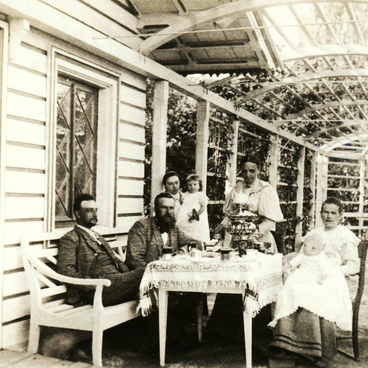Clocks formed an integral part of the interiors of Sarepta houses. The exhibited wall clocks were manufactured by the famous European factory owned by Gustav Becker.
The clock is made of dark brown wood and decorated with carved elements. They have a small round ceramic face with Roman numerals, metal openwork hands and Gustav Becker inscription. The striking clock has a golden colour pendulum. The mechanism is covered with a glass door.
Gustav Becker, a clockmaker, was born in Silesia, then part of Prussia, in 1819 (eighteen nineteen). In 1837 (eighteen nineteen thirty seven), Becker graduated from a clockmaking school and spent ten years to master his craft in Vienna. In 1847 (eighteen forty seven), he opened his own workshop in Freiburg. Unemployment that was widespread in Prussia at that time forced the clockmakers to move to other regions of Germany.
The advent of the spring clockwork make it possible for Gustav Becker’s factory to manufacture new floor-standing and wall-mounted clocks, as well as fireplace and desk versions. The shapes of their clocks are very diverse: there are both classic rectangular items and elegant combined-shaped clocks with beautiful repoussé decors. As for the clock faces, the factory also produced various types: with a single hour disc or several, with markings in Roman numerals or Arabic, with a complex or plain ornaments.
Like all watchmakers of the 19th century, Gustav Becker marked his products with his brand name that was his last name. The faces of the first manufactured lots often bore “Gustav Becker” inscription with various fonts. Some clocks had barely noticeable inscriptions, the others are inscribed with curly letters.
In 1852 (eighteen fifty two), Becker introduced his brand name that is easily identifiable to this day. He chose an anchor, crown and his initials as his activity symbol. He sought for protections against fraudsters, and wanted to make the mechanisms recognizable. To this end, Becker ordered to indicate the brand not only on mechanisms or faces, but also on various parts of the clock.
The clock is made of dark brown wood and decorated with carved elements. They have a small round ceramic face with Roman numerals, metal openwork hands and Gustav Becker inscription. The striking clock has a golden colour pendulum. The mechanism is covered with a glass door.
Gustav Becker, a clockmaker, was born in Silesia, then part of Prussia, in 1819 (eighteen nineteen). In 1837 (eighteen nineteen thirty seven), Becker graduated from a clockmaking school and spent ten years to master his craft in Vienna. In 1847 (eighteen forty seven), he opened his own workshop in Freiburg. Unemployment that was widespread in Prussia at that time forced the clockmakers to move to other regions of Germany.
The advent of the spring clockwork make it possible for Gustav Becker’s factory to manufacture new floor-standing and wall-mounted clocks, as well as fireplace and desk versions. The shapes of their clocks are very diverse: there are both classic rectangular items and elegant combined-shaped clocks with beautiful repoussé decors. As for the clock faces, the factory also produced various types: with a single hour disc or several, with markings in Roman numerals or Arabic, with a complex or plain ornaments.
Like all watchmakers of the 19th century, Gustav Becker marked his products with his brand name that was his last name. The faces of the first manufactured lots often bore “Gustav Becker” inscription with various fonts. Some clocks had barely noticeable inscriptions, the others are inscribed with curly letters.
In 1852 (eighteen fifty two), Becker introduced his brand name that is easily identifiable to this day. He chose an anchor, crown and his initials as his activity symbol. He sought for protections against fraudsters, and wanted to make the mechanisms recognizable. To this end, Becker ordered to indicate the brand not only on mechanisms or faces, but also on various parts of the clock.



